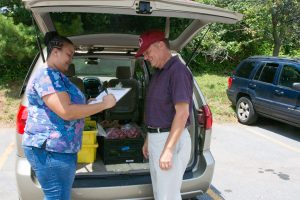Food Safety for Volunteer Food Runners
Thank you for helping to transport food from food donors to food assistance organizations! Below is everything you need to know to make sure you handle and transport food safely.
Watch these short, informative food safety videos for food runners.
Food Runner Guidelines For
Food Donation Pick Up & Delivery
Hand Washing Techniques for Food Safety
Food Safety Webinar from Community Food Rescue on Vimeo.
All CFR participants must follow county approved Food Safety Guidelines for safe handling, transportation and distribution of rescued food, which are available for downloading and printing. You’ll need to read these Guidelines and watch the videos above before taking the food safety quiz when you sign up in ChowMatch. Food runner specific guidelines are available for downloading and printing.
How do you know if food is safe to eat, even if the label is past the current date or a can is slightly dented? How do you properly store, thaw, cook, and freeze different types of foods? Read CFR’s Food Safety Brochure to find out, available as downloadable PDFs in these languages: English, French, Korean, Mandarin, Russian, Spanish, and Vietnamese.
If you’d like printed copies of English or and Spanish language brochures, please contact the Food Resources Team, FoodResources@mannafood.org.
Food Safety for Food Runners
Important information for volunteer food runners
Safe delivery of donated food requires responsible hygiene, timely delivery and clear communication.
If when picking up food from a food donor, you suspect that the food is not safe, accept the food and alert the recipient organization and the Food Resources Team– FoodResources@mannafood.org so they can follow up with the donor.
If you have any questions that aren’t answered below, please contact: Jenna Umbriac, Director of Community Impact, at Manna Food Center; jenna@mannafood.org.
Personal Hygiene Requirements
- If you’re sick, do not recover food.
- Wear, long pants, clean clothes, and closed-toed non-slip shoes.
- Do not wear excessive jewelry (watch and wedding band are ok).
- Pull long hair up and/or wear a hat/hairnet.
- Wear a waterproof bandage if you have a cut.
- Wash hands and exposed arms up to your elbows with warm water and soap before beginning your food run.
- Wash hands again if you do any of the following: use the restroom, smoke, touch your hair, face, clothes or body, eat or drink.
- Do not eat, drink, smoke or chew gum while on a food run.
Prepare your Vehicle
- Protect food from contamination from sources such as chemicals, staples, insects, water drippage, dirty equipment, etc.
- Keep your vehicle clean of excessive dirt, insects, animals, and any other potential contaminants while transporting food. It is a good idea to have a clean sheet, tarp or carry-all container that you lay in trunk or back seat before transporting any donated food.
Transport Food Safely
- Use safe, nonabsorbent, leak proof pans or reusable containers.
- Never put pans containing food on the ground.
- Use thermal bags or coolers (with ice packs for cold foods) to maintain hot or cold temperature of food; do not mix hot and cold food in the same carrier.
Special Instructions for Perishable Foods
- Perishable food, requires time-temperature control to prevent the growth of harmful bacteria and keep it safe for consumption.
- For potentially hazardous foods including frozen foods, hot or cold prepared foods, and fresh meat, seafood and dairy:
- When temperature-controlled transport is available, foods should be held below 40 ̊F or above 140 ̊ while in transport to the venue.
- Hot food must be received and held at a temperature of 140°F or above. Hot food out of temperature controls for any amount of time under 4 hours must be reheated to 165 ̊F before service. Please alert both the recipient organization and the Food Resources Team if it has been below 140˚F for more than 4 hours. Please alert the Food Resources Team if you suspect that a hot food donation has not been held at 140°F or above.
- Cold food must be received and held at a temperature of 40°F or below. Please alert the Food Resources Team if you suspect that a cold food donation has not been held at 40°F or below.
Food Safety Tools

Take these items on every food run:
- CFR Food Safety Guidelines
- Directions to donor and recipient locations and phone numbers
- CFR hat, car magnet, post cards to identify yourself as a CFR volunteer
- Mobile phone to check last minute food run emails or texts and take photos



